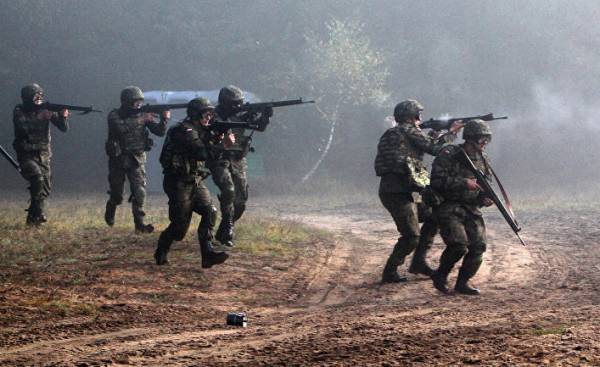
The military aggression of the Kremlin in Ukraine and Eastern Europe provoked the opposite effect: the countries of the region, in fact, create anti-Russian military Alliance, and NATO perevooruzhit and strengthens its Eastern flank.
In General, Eastern Europe is the fastest militaryservice region in the world, and it is not in the hands of Moscow.
“I think the military policy of Russia was defeated, since turned into a national resistance and the beginning of rearmament of NATO” — said a senior researcher at the American Foreign Policy Council.
“But the threat to Russia”, — he added, stressing that NATO and Ukraine have stepped up their military capabilities for defense and not for any offensive action. (…)
“Most likely, the military provocations against NATO with Russia will not stop, because the image of an unpredictable Putin the best Moscow — everyone is afraid of another war in Europe,” — says senior researcher of the Polish Institute of international relations Daniel Szeligowski.
Sowing doubts about whether “can NATO defend its members in case of aggression”, Russia, according to Zeligowskiego, trying again to assert its influence in the so-called “near abroad” — in fact, in the former Soviet Union.
The Russian gambit, apparently ricocheted
Nevertheless, the Russian gambit, apparently ricocheted. “Russian aggression against neighbors led to the fact that many NATO countries have changed their attitude to threats. Many of them, in the end, has taken steps to increase defence spending, says political analyst Daniel Cochise. — The us administration couldn’t achieve for decades.”
NATO
Russian aggression has led to the fact that NATO decided to rearm, and to develop a more assertive position in relation to Moscow.
Members of the Western military Alliance (originally created for the resistance to the Soviet Union) has promised to increase military spending. At the same time NATO deploys along its Eastern flank, in the direction of the Russian border, new powers, and in such scale not seen here since the cold war.
“Russia is trying to undermine solidarity and to exacerbate the disagreements within the bloc, says Cochise. — It is very important that NATO members stood as one front against these relentless attempts”.
At the meeting of defence Ministers of NATO countries in the headquarters of NATO in Brussels the defense Minister James Mattis had insisted that all member countries spend on defense at least 2% of GDP. At the moment only five countries — the U.S., Estonia, Greece, Poland and Britain — to fulfil that obligation.
“America may not worry about your children more than you do,” said Mattis during his speech.
In response to Russia’s military actions in Ukraine, NATO plans to send to the Russian border four battalion 1 thousand soldiers each, one battalion to the Baltic States, and the fourth in Poland.
In addition, there are forces very high readiness, which has about five thousand troops. This unit is written on the website of NATO, should “respond to the unexpected threat posed by Russia and risks emanating from the Middle East and North Africa.”
The number of American forces in Europe is about 35 thousand troops, including two infantry brigades. To deter Moscow had recently deployed one brigade in Poland (population of 3,500 soldiers and 87 tanks in service). Another division — numbering 500 soldiers have been deployed in Romania.
The us military is in Ukraine. Here they conduct military exercises for the Ukrainian armed forces.
“The United States reaffirmed their commitment to the fifth article of the Statute of NATO. Russia will have to recognize that these guarantees remain immutable, says Cochise. — Any deviation from these guarantees only leads to aggression and miscalculations”.
The broad picture
The buildup of NATO forces on the Eastern flank slightly compared to that deployed on the border with Russia Ukraine. Because of Russian aggression, the military balance of power in Europe in 2014 has changed.
Ukraine turned Donbass 60 thousand soldiers, along with heavy artillery and equipment. Until 2014, forces of similar magnitude on the border of Russia was not.
“Russia’s actions in Ukraine — it is primarily about internal Russian politics, says Cochise. — A stable, economically prosperous Ukraine on the border with Russia to the Russian regime is a threat”. (…)
The inevitability
Estonia, Latvia and Lithuania, formerly part of the Soviet Union, and now members of NATO are increasing its military capabilities faster than any other country in the world.
According to Jane’s Information Group, Baltic countries collectively increased spending on new military equipment with $ 210 million in 2014 to 390 millionof dollars in 2016. By 2020, the total defense budget of the Baltic States will be $ 2.1 billion (for comparison, in 2005 was 930 million dollars).
Poland, which is also a NATO member, since 2006 has increased its military spending in half. In 2016, they amounted to 9.2 billion dollars. Over the past ten years, military expenditure of Poland increased eight times. In 2015, for example, this figure had jumped to 18%.
Even Sweden and Finland, countries that were mostly retained neutral status throughout the cold war, began to increase its military potential because of the Russian threat.
According to the British publication the Independent, the Finnish authorities are thinking about how to ban some foreigners from buying property close to military installations because they fear that the Russians can buy land that can be used for the invasion. (…)
Priorities
Many analysts compare the current friction between Russia and NATO with the cold war. They see this conflict through bipolar lenses: NATO on the one hand, Russia and its minions on the other.
However, the situation in Eastern Europe is not so easily reduced to the paradigm of the cold war. This region is no longer a no man’s land (from a geopolitical point of view). Now here is a multipolar regional power struggle. However, the Eastern members of NATO remain committed to the Alliance.
“For Poland, NATO’s fifth article is and will be a key element of security policy, says Szeligowski. Therefore, the Polish government will try to strengthen its ties with the United States and to encourage European members of NATO to increase their military budgets”.
But within NATO there is no agreement about what is for the Alliance to be the main threat.
Some high officials of Western European NATO countries and of the American officials believe that the main threat to the Alliance are terrorists who come from such hot spots as Iraq and Syria. But the Eastern European countries believe that the main threat to NATO is Russia.
“Terrorism and instability emanating from the Middle East and North Africa are a threat to NATO members, and only Russia is a real existential threat to the Alliance,” concludes the Cochise.
Nolan Peterson, international correspondent for The Daily Signal, a former U.S. air force pilot and veteran of the wars in Iraq and Afghanistan.







